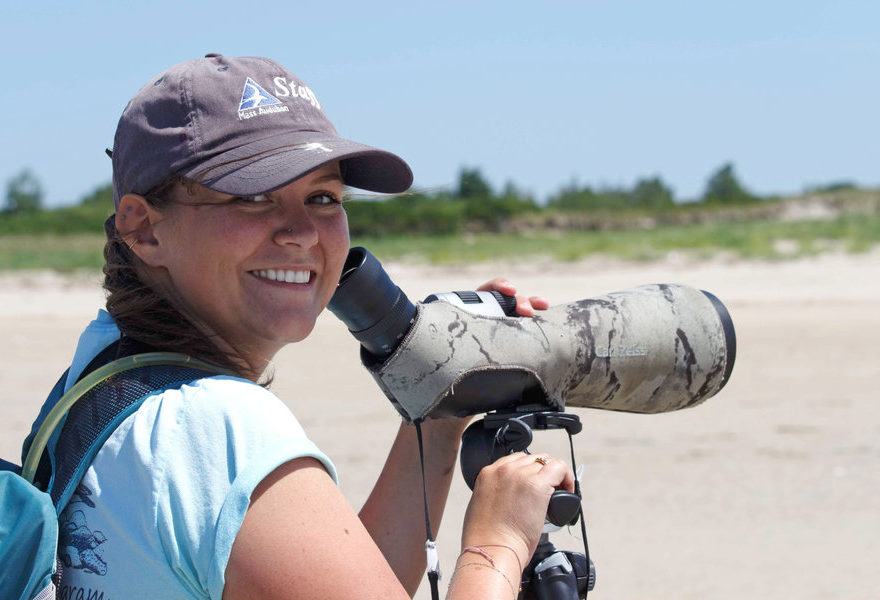By Doug Struck Correspondent
Jorge J. Ayub scanned the public beach north of Boston on a hot summer weekend, already crowded with what was predicted to be 1 million people drawn to the annual sand sculpture festival. Traffic on the adjacent road was bumper-to-bumper, amplified bands pounded out hip-hop, and later that night fireworks would boom and sizzle over the beach.
And on the sand were four pairs of tiny, wary shorebirds, brooding over chicks still too young to fly – those chicks a precious addition to the national effort to save a bird once down to 139 breeding pairs in Massachusetts.
It was Mr. Ayub’s job to help protect the piping plovers.
“Everyone made it,” Ayub, a coastal ecologist for the Massachusetts Department of Conservation and Recreation, reported at the end of the long weekend watching over the nests.
Piping plovers are photogenic shorebirds that migrate from the southern US and the Caribbean in the spring. They mate and nest on the Atlantic shore from South Carolina to Newfoundland. Once common, they were hunted and then squeezed out of their habitats by coastal development until, in 1986, the federal government listed the Atlantic Coast birds as threatened. The listing created a web of protectors: multiple agencies, nonprofit groups, and volunteer conservationists.
The bird’s recovery has been slow and halting. After three decades, the Atlantic population stands just under the 2,000-pair goal set by federal law.
But the star has been Massachusetts, which has seen plovers increase to a high of 687 pairs from 139 pairs in 1986, busting the goal for the entire New England region. One reason for that: intensive “chick-sitting,” in which conservationists sometimes spend all day watching over the birds, and a growing accommodation between people and plovers.
“There’s still some tension with sharing the beach, but in general the support of beach communities has been phenomenal,” says Kathy Parsons, director of the coastal waterbird program at Mass Audubon. “That’s been the success story in Massachusetts.”
That progress has made Massachusetts the only East Coast state with discretion to relax some Endangered Species restrictions, to reduce the fenced-off areas and vehicle limits that have so annoyed residents.
“Look at this stretch,” Ayub says on a stroll of the 2.6-mile Revere Beach. “We had six nesting pairs between here and that bathhouse 600 yards away. By regulation, each nest should have 100 yards of fencing. We could have put up fencing and closed the beach all the way to the bathhouse.”
Instead, the plovers are surrounded in much smaller areas by “symbolic” fencing – thin fiberglass poles with twine stretched between them and small blue signs. None of the 52 seawall entrances to the beach is closed, and Ayub has used his rare federal permission to deter one pair from nesting too close to another bathhouse containing lifeguard equipment.
“If we put up too much fencing, people will be upset, and they are going to vandalize it or walk right through the nesting areas,” Ayub says. “By opening the beach, people are happier and the species does better.” Authorities elsewhere are looking at that model; disputes have flared over beach closings in Martha’s Vineyard, Cape Cod, and a smattering of towns along the coast.
The concessions have not won over everyone. “We’re at the mercy of the birds,” says Robert Marra Jr., chief of staff in the Revere mayor’s office. “The fenced areas have grown and grown.”
Ayub says the fencing has taken only 14 percent of Revere Beach – even less at low tide – and is removed as soon as the chicks take flight. But conservationists are resigned that there will always be complaints.
“I’ve been called a Nazi a few times,” says Jess McClean, who works for Mass Audubon on a state contract to monitor three beaches. Ms. McClean, a native of Scotland, discovered an affection for bird conservation in Texas, and moved to Massachusetts to help protect the piping plover. She has a small tattoo of a plover on her left wrist.
“They are small and round and adorable. They melt my heart,” she says while patrolling the Sandy Point State Reservation on Plum Island, in Newburyport, Mass., 35 miles north of Boston.
Plover chicks lead a risky existence. They rely on perfectly camouflaged coloring, but often freeze when threatened. Vehicles and people running on the beach can inadvertently squash them. Dogs, crows, coyotes, gulls, and storms can wreak havoc with a year’s brood. In Revere, they lost 24 chicks to a hawk last year and 15 nests this year to crows.
Plover adults, while only about six inches tall, have bursts of speed in the air and on the ground, where they race in a comic zig-zag that can avoid most trouble. But chicks cannot fly for about four weeks, and must forage for their own meals immediately after hatching. As they scamper down to the water’s edge to feed on small insects and worms in seaweed washed ashore, they are vulnerable to predators and to children who cannot resist chasing them.
“We’ve rescued them from under kids’ sand pails,” says Ayub.
Usually though, McClean notes, when she explains the plovers’ plight, people become protective.
“When you can point out those fuzz-ball little chicks, people get excited,” she says.
“This is a remarkable conservation story,” says Anne Hecht, the piping plover recovery coordinator for the US Fish and Wildlife Service. “This is an incredibly lucky little bird. This bird faces huge threats but it has an amazing group of really, really dedicated people helping it.”


